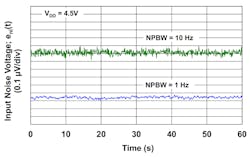45-V “Zero-Drift” Op Amp Merges Extreme Precision, EMI Filtering
In these days of highly integrated mixed-signal ICs and single-digit power rails, is there even a place for higher-voltage, single-function discrete op amps? In a word—yes—and vendors recognize the opportunities.
For evidence, consider the MCP6V51 op amp from Microchip Technology Inc. This 45-V device targets industrial control and factory automation as well as other specialty applications like medical devices and scientific instruments. In addition to the higher-voltage rating are precision features such as almost-zero offset drift, which eliminates the need for calibration or data correction, plus integral EMI filtering, which is often a necessity in its noisy operating scenarios.
EMI rejection is provided by an integral second-order RC low-pass filter that sets a bandwidth limit of approximately 115 MHz and attenuates high-frequency interference (Fig. 1).
1. The EMIRR vs. frequency graph shows the MCP6V51’s EMI rejection ratio (EMIRR) with 4.5- and 45-V VDD rails. (Source: Microchip Technology Inc.)
Its self-correcting “zero-drift” architecture enables ultra-high dc precision, with a maximum initial offset voltage of just ±15 µV and minuscule maximum offset drift of ±36 nV/°C. Typical quiescent current IQ of this op amp, which operates from a single-ended 4- to 45-V supply (or split ±2.25- to ±22.5-V rails), is 470 μA.
The rail-to-rail op amp is unity-gain stable and has a 2-MHz gain bandwidth (GBW) product—adequate for its targeted applications—along with a 1.2-V/µs slew rate and open-loop gain of 140 dB. Power-supply rejection ratio (PSRR) and common-mode rejection ratio (CMRR) are 135 dB and 135 dB, respectively (the three dB specifications are minimum values for these parameters). Noise is 10.2 nV/√Hz at 1 kHz while input noise voltage is 0.21 μV p-p from 0.1 Hz to 10 Hz, and input-referred noise (Eni) is also very low (Fig. 2).
2. The input noise voltage vs. time with 1- and 10-Hz filters for 4.5-V (top) and 45-V VDD rails (bottom) is also very low and well-behaved. (Source: Microchip Technology Inc.)
As with most higher-performance op amps, the datasheet is a detailed repository of performance graphs across various parameters, application notes, suggested circuits, and more. Further supporting this basic component is Microchip’s SOIC8EV Evaluation board used for its 8-pin op amps. Pins of a device that are soldered to this “blank” PCB are connected to pull-up, pull-down, and in-line resistors as well as a loading capacitor. Additional pads support use of through-hole or surface-mount connectors for connection to the board. Furthermore, there are component “footprints” for passive components so that simple circuits can be implemented and an op amp’s performance evaluated.
The MCP6V51 is available in 5-lead SOT-23 and 8-lead MSOP packages, with prices beginning at $0.98 USD (10,000-piece lots) for the SOT-23-5 package version.
About the Author

Bill Schweber
Contributing Editor
Bill Schweber is an electronics engineer who has written three textbooks on electronic communications systems, as well as hundreds of technical articles, opinion columns, and product features. In past roles, he worked as a technical website manager for multiple topic-specific sites for EE Times, as well as both the Executive Editor and Analog Editor at EDN.
At Analog Devices Inc., Bill was in marketing communications (public relations). As a result, he has been on both sides of the technical PR function, presenting company products, stories, and messages to the media and also as the recipient of these.
Prior to the MarCom role at Analog, Bill was associate editor of their respected technical journal and worked in their product marketing and applications engineering groups. Before those roles, he was at Instron Corp., doing hands-on analog- and power-circuit design and systems integration for materials-testing machine controls.
Bill has an MSEE (Univ. of Mass) and BSEE (Columbia Univ.), is a Registered Professional Engineer, and holds an Advanced Class amateur radio license. He has also planned, written, and presented online courses on a variety of engineering topics, including MOSFET basics, ADC selection, and driving LEDs.




